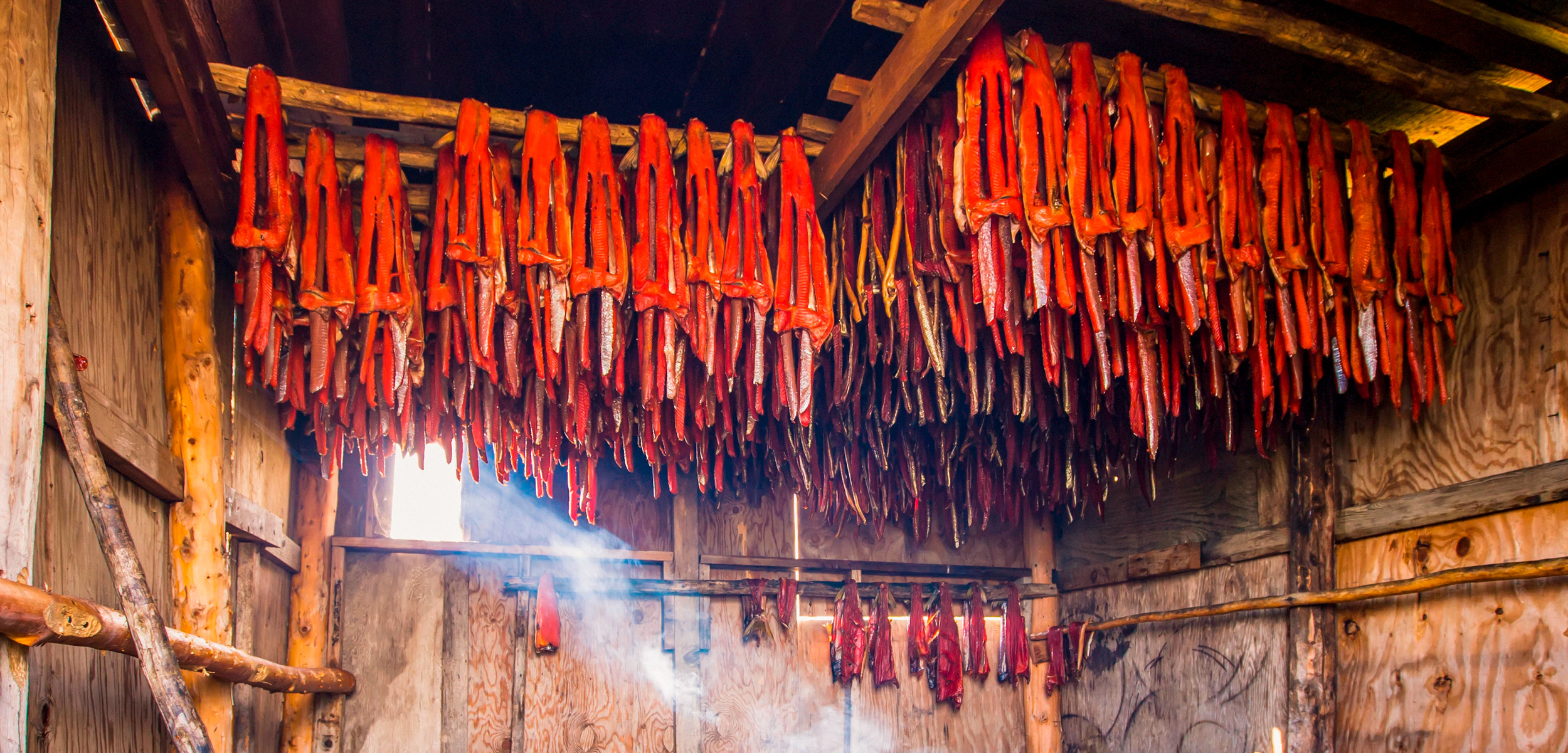Sharing Food, Building Resilience
In some small coastal communities of Alaska and British Columbia, wealth is also measured by how much food you can give.
Article body copy
Google the village of Port Heiden along the Alaska Peninsula and you’ll likely stumble upon alarming images of erosion, maybe even a video of the community’s Goldfish Lake breaching like Niagara Falls into the Bering Sea. The community started voluntarily relocating inland in the 1980s due to its shifting coastline. A big storm surge can reclaim up to 30 meters of the volcanic pumice shore at a time—roughly the length of two city buses. Erosion updates on the village Facebook page show the main access road to the original village site is nearly no longer.
Yet the erosion, accelerated by sea level rise and intensifying storms, is only one disruptive force demanding adaptation in Port Heiden, also known as Meshik in Sugpiaq. The community has weathered economic booms and busts throughout its colonial history. Russian fur traders invaded and settled in the late 1700s, hunting until fur-bearing sea mammals were nearly wiped out. Salmon canneries and an influx of outside workers came afterward, and in 1919, just as the salmon fishery had its first major collapse, the influenza epidemic devastated the region, forcing a near-total abandonment of Meshik. During the Second World War, the US military temporarily stationed thousands of soldiers nearby to guard against a Japanese invasion, transforming the isolated region with large-scale housing, airfields, refueling sites, and other military infrastructure. Community members are now employed to clean up the chemical mess left behind.
Today, the region’s US $300-million sockeye fishery is one of the world’s largest, and roughly 13,000 workers migrate here to participate every season. Though a boon to many, this latest rush of wealth largely flows out of state. Of the 98 people who live in Port Heiden year-round, most of whom are Sugpiaq or Alutiiq, only eight carry commercial fishing permits. There are a fixed number of permits, and for various financial reasons, many locals have sold theirs to eager outsiders. With the average gill net license now valued at $200,000, few can afford to buy them back.
By standard metrics, the community is poor. The median household income in Port Heiden is $47,000, about half that of Alaska’s largest city, Anchorage. But if you were to fly into Port Heiden in June or July, you’d likely see a display of a different kind of wealth—villagers, some on their day off from commercial fishing, hauling a bounty of subsistence salmon from set-nets, which hang like a wall in the ocean, attached to the seafloor. At the Christensen household, you’d see kids gathered around fish-cutting tables, helping wash three or four dozen freshly caught kings, also known as chinook, from Meshik Bay. With each king weighing between nine and 14 kilograms, this catch is enough to fill a smokehouse and supply five families through winter. The youngest workers would be making their first slices with ulus, traditional arc-shaped knives, by cutting dry fish into bite-sized pieces. Others would be removing heads and guts or helping prepare strips of fish for the smokehouse. The matriarch of the family would be calling the orders, encouraging the older kids to jump on the four-wheeler and run extra fish over to extended family and friends.
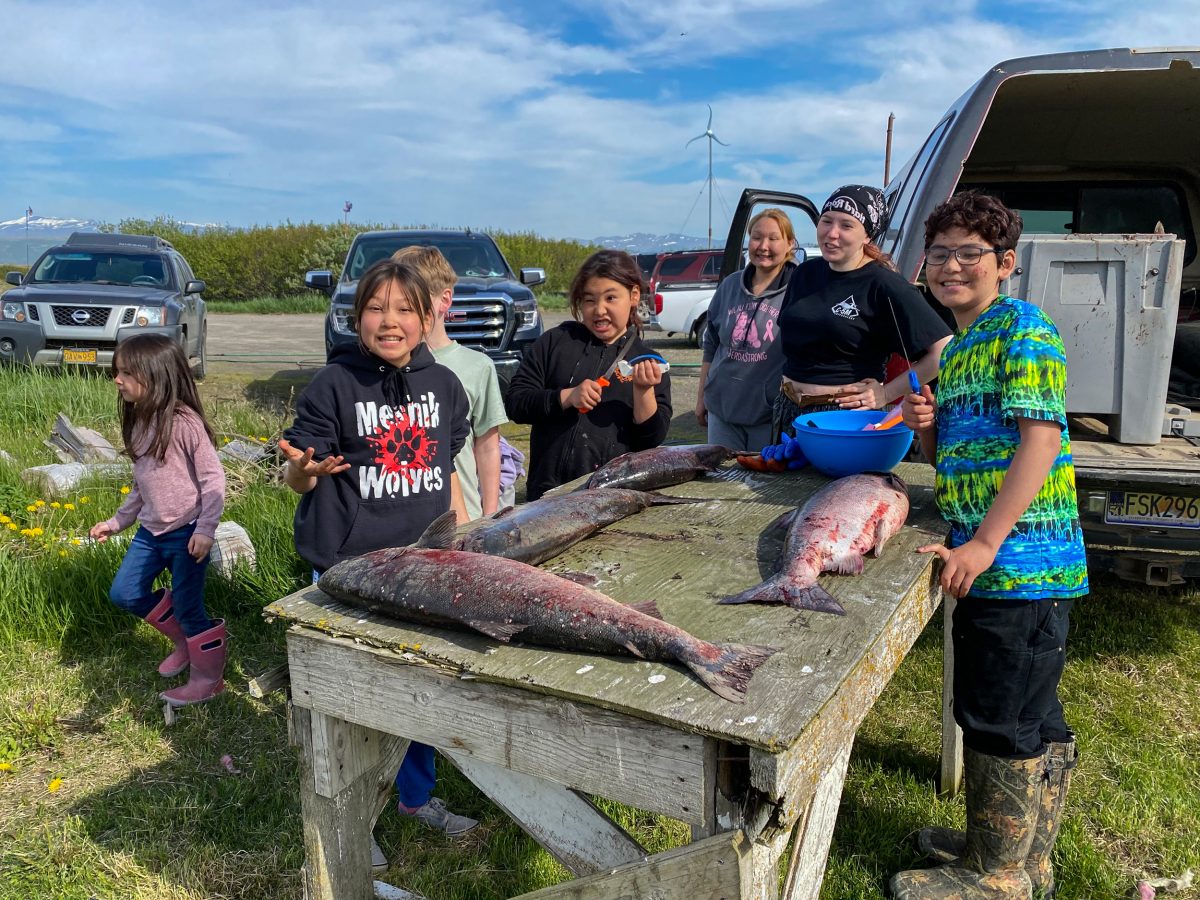
In Port Heiden, Alaska, young workers get ready to head, gut, and fillet king salmon, a task that brings the entire family together. Photo courtesy of Jaclyn Christensen
“One of the favorite things kids love to do is to give fish away,” says Jaclyn Christensen, a Yup’ik and Sugpiaq mother of four children ranging from one to 12 years old. Sharing is a value instilled from a very young age. “They think they’re just going for a Honda ride and getting away from all the work,” she says. “But it’s actually teaching them always to give if you have more than enough.” That sharing extends far beyond Port Heiden. Last fall, Christensen brought five fillets of coho with her to Anchorage to share with family members. “I send them blackberries and silver salmon, kings, reds, anything I have,” she says. Gifting food is “like saying, I love you.”
In a community where a jug of fresh milk is considered a luxury item, with a $20 price tag, fish shared from the Christensen smokehouse contributes nutritious food to freezers and pantries throughout the long, cold winter months. But each act of sharing involved in bringing salmon to a loved one’s dinner table—from mending nets to delivery, and even child care—serves an additional purpose. It gives a reason to check in with those who can’t fish themselves and to ensure they have everything else they need, like medication, a working furnace, and a shoveled driveway. Together, these interactions keep families and community members connected and thriving even during times of duress—providing support that’s just as essential to human survival as food.
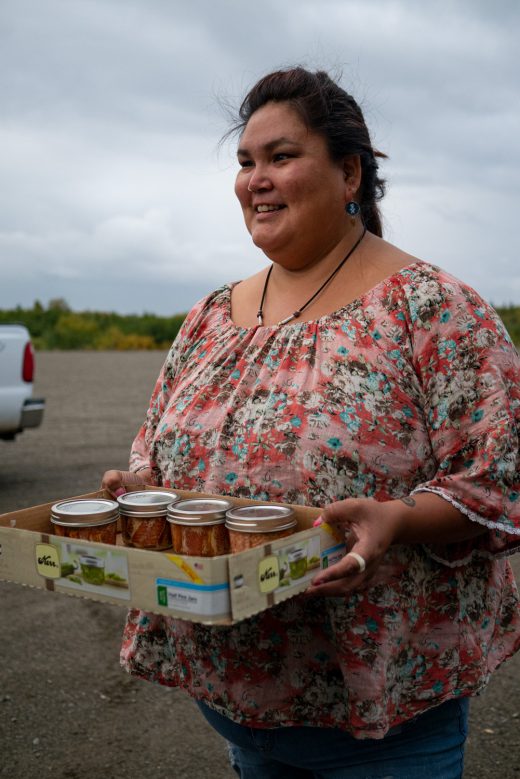
Ida Nelson of Igiugig, Alaska, holds jars of salmon to share as a farewell gift to visitors. She says sharing food is a way of also sharing her culture. Photo by Lauren Kaljur
Ida Nelson of the Bristol Bay village of Igiugig is Yup’ik and a single working mom. Because she doesn’t have the time to fish and hunt, she welcomes gifts of moose and fish each year. “I think we’re a lot richer than the statistics say we are,” she says.
“When you have enough of a resource to share, that in itself is a way to measure your wealth,” explains Cody Larson, subsistence fisheries scientist with the Bristol Bay Native Association, which represents a consortium of 31 tribes from the mainland and peninsula along Bristol Bay, including the Alaska Peninsula. Larson and his colleagues recently wrapped up more than four years of data collection, interviews, and analyses in collaboration with six communities, including Port Heiden, to document and illustrate the extent to which subsistence salmon is collaboratively processed and shared. With help from state and federal fisheries departments and mapping technology from Oregon State University, they’ve been able to visualize the invisible, displaying the complex webs of gifted and received salmon and associated labor, much like a fish net. Most gifts of fish travel within and between communities. But Larson was surprised to find out just how many travel hundreds of kilometers to Anchorage, to the state of Georgia, and even to Japan.
Through the lens of a sharing economy, these communities not only care for their own, they provide a sense of identity to the growing number of rural Alaskans who have relocated to urban areas, says Larson. A sense of belonging supports well-being for those living in the city and maintains the bonds necessary for the long-term survival of the village itself. Younger generations must feel a connection to home in order to return and stay invested in community, explains Larson. They might come back to serve on tribal councils, for example, or advocate for the more tangible components of rural life: air access, docks, and drinking water. That infrastructure, in turn, benefits the commercial sector, including Bristol Bay’s world famous sockeye fishery, says Larson.

A set-net, also known as a drift net, filled with salmon is spread out along Bristol Bay, Alaska. Photo by Bronwyn Jones, courtesy of Cody Larson
Around the world, governments have been searching for more comprehensive ways to measure well-being. For years, the proxy for success has been gross domestic product or job growth. But these metrics alone don’t tell us how a community is doing socially, says Larson. They won’t help us understand and address crises like the lack of affordable housing, income inequality, and social isolation. In psychologist Abraham Maslow’s famous hierarchy of human needs, depicted as a pyramid, the need for belonging and connection sits just above the very basics: such as food, water, sleep, and safety. At the same time, there’s a growing interest among academics and Indigenous leaders in measuring the many dimensions of well-being on Indigenous terms. With so many challenges facing rural Indigenous communities, from climate disruption to out-migration, leaders need relevant and innovative data to inform action. That’s where Larson and his team’s work comes in. If someone wants to know how a community is doing, the response, Larson explains, could be, “Well, how many times did people share food with each other here?” Each community’s constellation of shared food, labor, and equipment, like nets or boats, is unique and reveals different levels of interconnection and community cohesion. With data on the health of a community’s social fabric, leaders can be proactive in maintaining it. That might include making upgrades to community docks or processing plants that support collaborative fishing, for instance, implementing a subsistence calendar to encourage harvesting, or paying closer attention to whether or not there’s enough fish to go around. “If there’s 3,000 fish harvested,” says Larson, “the $15,000 that that’s worth on a commercial scale is way outpaced by the value of that to the subsistence users in terms of connectedness.”

Cody Larson, subsistence fisheries scientist with the Bristol Bay Native Association, studies food sharing as a measure of resilience with communities in Bristol Bay, most of which are only accessible by plane. Photo by Bronwyn Jones, courtesy of Cody Larson
Many of us have experience with the sense of well-being tied to sharing food with friends and family or sharing service through volunteering. These interactions don’t just feel good—they keep communities going. Libraries, care homes, food banks, and school boards can barely function without gifted labor and goods. Researchers in Japan found that food shared from home gardens in rural areas with family and friends enhances nutritional and social well-being, and even resilience to natural and economic disasters. They found less sharing and fewer relationships in urban areas. Like other social scientists, they hope that emerging forms of sharing facilitated by smartphone apps might help sustain sharing culture—and maybe even remedy the dislocation and isolation so apparent in urban centers around the world.
Each community’s approach to sharing is unique, and some are more formalized than others. Along the Pacific Northwest, the potlatch is a well-known institution of sharing, involving elaborate gifts of food and other valued goods, from carvings to coffee. These complex political and ceremonial gatherings are like economic investments in community, as Ogwi’low’gwa, a member of Qualicum First Nation, puts it. They make sure everyone has what they need, while teaching social, cultural, and ecological values, like the importance of conserving shared resources.
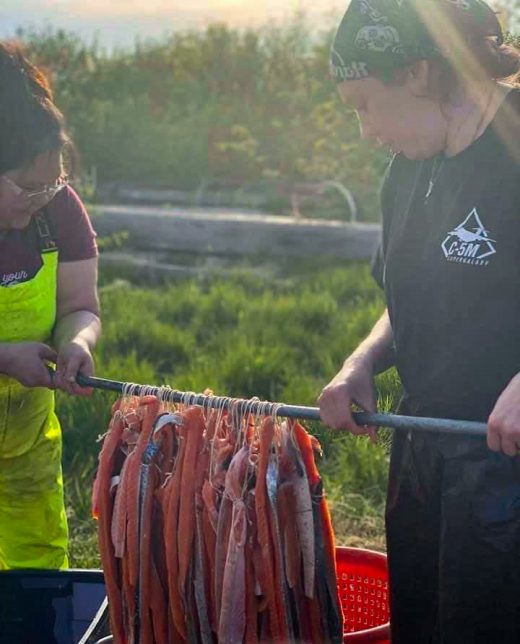
Jaclyn Christensen (left) and Tisha Kalmakoff dip strips of king salmon fillets into a brine in preparation for the smokehouse. Photo courtesy of Jaclyn Christensen
But what happens when a shared resource disappears entirely? It’s a grim reality the Nuxalk Nation, located in and around Bella Coola, British Columbia, knows too well. Over thousands of years, a tiny smelt with as many uses as names—eulachon, hooligan, ooligan, salvation fish, candle fish—was traded along “grease trails” up and down the Pacific coast, linking First Nations as far north as Bristol Bay and as far south as the Klamath River in California. Through trade, even interior peoples as far inland as Kamloops, British Columbia, more than 250 kilometers from the coast, enjoyed eulachon. When Marlene King, a grandmother of five and cultural leader for Nuxalk College, was a little girl, rivers would run black with sputc, she says, the Nuxalk word for eulachon. “When we were kids, it was so abundant it was just a natural thing to go to the fridge and have eulachon grease,” King says. Grease—oil rendered from eulachon—is part commodity, part condiment, part medicine rich in vitamins A, E, and K and healthy fats.
Spring marked a time when the entire community came together for the short, labor-intensive harvest at fish camps, followed by collective processing. The oil was then refined, bottled, and distributed among members, especially elders. Camps would run all up and down the riverbank, King explains, and the entire community was invited, non-Indigenous included. Just like in Port Heiden, food shared among Nuxalkmc, as Nuxalk people call themselves, is a conduit for a much deeper form of sustenance, the kind that comes from smiles and thanks. “We would just share and share and share,” King says. “That was just what you did; we’re always sharing.”
But in the spring of 1999, eulachon failed to return to the Bella Coola River and have returned in unharvestable numbers ever since. In 2011, the Committee on the Status of Endangered Wildlife in Canada officially assessed Fraser River and central Pacific coast eulachon populations as endangered, citing a combination of pressures, from shrimp trawling to climate change. For Nuxalkmc, a cultural keystone harvest ground to a halt.
“Now, people are lucky to get eulachon grease,” says King. They’re lucky because four years ago, the community began hauling eulachon from Nisga’a Nation lands more than 1,200 kilometers north by road. For the first time in two decades, a Nuxalk eulachon grease camp was back in operation. That first year, 500 jars of oil went to a school’s play potlatch, where kids run their own dances and ceremonies and distribute gifts. The community witnessed a tradition that for thousands of years had marked the salvation of spring. “With the making of the grease, the culture, the language, the traditions all come together,” King says. “lt brings the best out of people.”
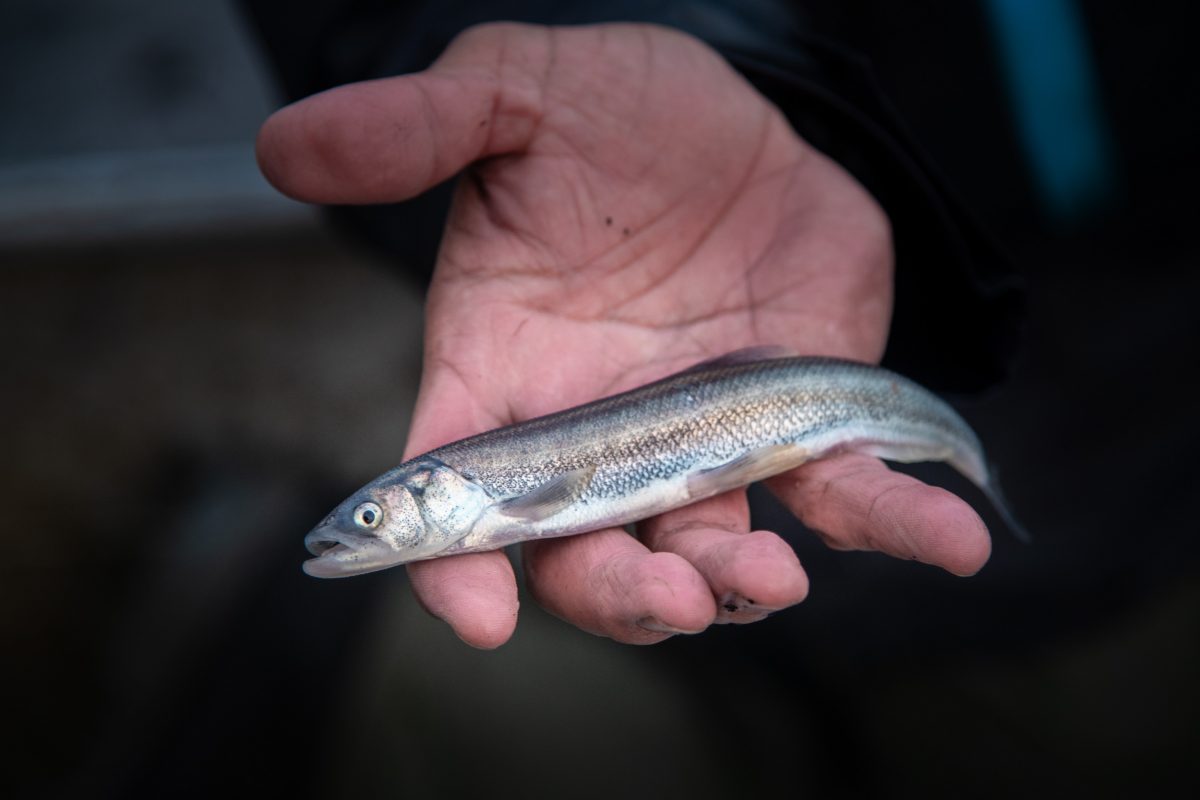
For many Indigenous communities in the Pacific Northwest, eulachon has deep cultural meaning, from the way it’s caught to how it’s shared. Photo by Shanna Baker
In 2014, before the return of the grease camp, the community had rekindled a sputc ceremony dating back over 100 years, which was complemented by the raising of a sputc pole on the bank of the Bella Coola River. The pole depicts a raven holding a male and female eulachon in open hands, as they were first brought to the people. Rachelle Beveridge, a PhD candidate at the University of Victoria in British Columbia who worked with the community to research the relationship between eulachon, stewardship, and well-being, writes that just as the loss of eulachon marked a decline in quality of life, so the revival of traditions reaffirmed well-being. Empowered with traditional knowledge, Nuxalkmc are now leading their own research on Bella Coola River eulachon abundance and status.
Deanna Nyce studies challenges faced by traditional Nisga’a leadership in a changing environment and is a leader and educator at the Wilp Wilxo’oskwhl Nisga’a Institute, an Indigenous post-secondary school in Gitwinksihlkw, British Columbia. She says that traditional food-sharing practices are inextricably linked to responsible stewardship of the resource. Eulachon harvesting in Nisga’a territory is governed by traditional laws. “You take what you need and use what you take,” she says. “That’s sort of been our unwritten modus operandi, forever, forever, forever.” It’s this unwritten rule that ensures there’s enough fish for the community to enjoy and share in future years. With three degrees from the University of British Columbia’s Vancouver campus, Nyce says sharing eulachon is part of being Nisga’a in the city. She remembers coming home from class one day to see her youngest daughter, in grade four at the time, sitting at the dining table offering dried salmon dipped in eulachon oil to her friends. “And her friends from school loved it,” Nyce says. When there’s less fish, everybody feels the impact.
Like the Nuxalk, communities in Alaska know what can happen when fish fail to materialize. The sockeye run of Bristol Bay broke records in the past two years but was almost nonexistent two other years in recent history. In 2018, the Chignik region neighboring Port Heiden experienced one of the worst sockeye seasons on record. The state allocated disaster funds, and food banks stretched to their limits as commercial fishers found themselves out of work. Larson was there at the time and interviewed residents about subsistence sharing. Many said that with fewer sockeye, they shared less. But he’s careful to point out that his team’s research only looked at salmon, and at a single moment in time. He’s observed locals share other species of fish when salmon are scarce. What might a network map reveal if the researchers had also considered berries, caribou, moose, and other fish? Berries and caribou have suffered declines in recent years, too, but a rich diversity in shared resources makes the whole system resilient.
Between the unforgiving environment, the impacts of colonization, and now the COVID-19 pandemic, sharing remains critical in Port Heiden. “[Sharing] is so deeply rooted in who we are that we display it in so many different ways—we don’t know how to live without it,” Christensen says. In recent months, the community has distributed boxes of food staples like onions and potatoes, provided fuel for home heating and electricity, and secured funds for temporary beds and medical equipment in the event SARS-CoV-2 arrives in Port Heiden.
When Christensen reflects on the value of food sharing to her community, she thinks about an exchange she had with an uncle. He offered her a cup of salmonberries, which can fetch around $100 per liter. Knowing the value, she offered to pay him. “And he just got mad,” she recounts. She says she has to remind herself that gifts from her family come from the heart. “My job is just to accept and enjoy,” she says. No matter how scarce or expensive, the lesson is clear: some things in life are priceless.
Reporting for this article was supported by the Institute for Journalism and Natural Resources.

